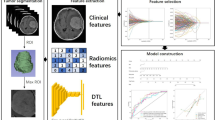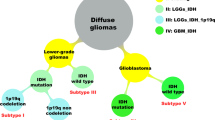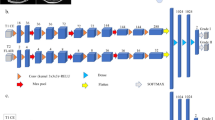Abstract
Objectives
To establish a deep learning (DL) model for predicting tumor grades and expression of pathologic markers of meningioma.
Methods
A total of 1192 meningioma patients from two centers who underwent surgical resection between September 2018 and December 2021 were retrospectively included. The pathological data and post-contrast T1-weight images for each patient were collected. The patients from institute I were subdivided into training, validation, and testing sets, while the patients from institute II served as the external testing cohort. The fine-tuned ResNet50 model based on transfer learning was adopted to classify WHO grade in the whole cohort and predict Ki-67 index, H3K27me3, and progesterone receptor (PR) status of grade 1 meningiomas. The predictive performance was evaluated by the accuracy and loss curve, confusion matrix, receiver operating characteristic curve (ROC), and area under curve (AUC).
Results
The DL prediction model for each label achieved high predictive performance in two cohorts. For WHO grade prediction, the area under the curve (AUC) was 0.966 (95%CI 0.957–0.975) in the internal testing set and 0.669 (95%CI 0.643–0.695) in the external validation cohort. The AUC in predicting Ki-67 index, H3K27me3, and PR status were 0.905 (95%CI 0.895–0.915), 0.773 (95%CI 0.760–0.786), and 0.771 (95%CI 0.750–0.792) in the internal testing set and 0.591 (95%CI 0.562–0.620), 0.658 (95%CI 0.648–0.668), and 0.703 (95%CI 0.674–0.732) in the external validation cohort, respectively.
Conclusion
DL models can preoperatively predict meningioma grades and pathologic marker expression with favorable predictive performance.
Clinical relevance statement
Our DL model could predict meningioma grades and expression of pathologic markers and identify high-risk patients with WHO grade 1 meningioma, which would suggest a more aggressive operative intervention preoperatively and a more frequent follow-up schedule postoperatively.
Key Points
-
WHO grades and some pathologic markers of meningioma were associated with therapeutic strategies and clinical outcomes.
-
A deep learning–based approach was employed to develop a model for predicting meningioma grades and the expression of pathologic markers.
-
Preoperative prediction of meningioma grades and the expression of pathologic markers was beneficial for clinical decision-making.






Similar content being viewed by others
Abbreviations
- ACC:
-
Accuracy
- AUC:
-
Area under curve
- CI:
-
Confidence interval
- CNNs:
-
Convolutional neural networks
- CNS:
-
Central nervous system
- DL:
-
Deep learning
- FC:
-
Fully connected
- GFAP:
-
Glial fibrillary acidic protein
- H3K27me3:
-
Trimethylation of lysine 27 (K27) of histone H3
- IDH:
-
Isocitrate dehydrogenase
- IHC:
-
Immunohistochemical
- MITK:
-
Medical Imaging Interaction Toolkit
- ML:
-
Machine learning
- MRI:
-
Magnetic resonance imaging
- PR:
-
Progesterone receptor
- ROC:
-
Receiver operating characteristic curve
- T1C:
-
Contrast-enhanced T1-weighted
- WHO:
-
World Health Organization
References
Ostrom QT, Cioffi G, Waite K, Kruchko C, Barnholtz-Sloan JS (2021) CBTRUS Statistical Report: primary brain and other central nervous system tumors diagnosed in the United States in 2014-2018. Neuro Oncol 23:iii1-iii105
Louis DN, Perry A, Wesseling P et al (2021) The 2021 WHO Classification of Tumors of the Central Nervous System: a summary. Neuro Oncol 23:1231–1251
Goldbrunner R, Minniti G, Preusser M et al (2016) EANO guidelines for the diagnosis and treatment of meningiomas. Lancet Oncol 17:e383–e391
Scholzen T, Gerdes J (2000) The Ki-67 protein: from the known and the unknown. J Cell Physiol 182:311–322
Khanna O, Fathi Kazerooni A, Farrell CJ et al (2021) Machine learning using multiparametric magnetic resonance imaging radiomic feature analysis to predict Ki-67 in World Health Organization grade I meningiomas. Neurosurgery 89:928–936
Haddad AF, Young JS, Kanungo I et al (2020) WHO grade I meningioma recurrence: identifying high risk patients using histopathological features and the MIB-1 index. Front Oncol 10:1522
Behling F, Fodi C, Gepfner-Tuma I et al (2021) H3K27me3 loss indicates an increased risk of recurrence in the Tubingen meningioma cohort. Neuro Oncol 23:1273–1281
Gehring M, Reik W, Henikoff S (2009) DNA demethylation by DNA repair. Trends Genet 25:82–90
Ngollo M, Lebert A, Daures M et al (2017) Global analysis of H3K27me3 as an epigenetic marker in prostate cancer progression. BMC Cancer 17:261
Katz LM, Hielscher T, Liechty B et al (2018) Loss of histone H3K27me3 identifies a subset of meningiomas with increased risk of recurrence. Acta Neuropathol 135:955–963
Nassiri F, Wang JZ, Singh O et al (2021) Loss of H3K27me3 in meningiomas. Neuro Oncol 23:1282–1291
Maiuri F, Mariniello G, de Divitiis O et al (2021) Progesterone receptor expression in meningiomas: pathological and prognostic implications. Front Oncol 11:611218
Pravdenkova S, Al-Mefty O, Sawyer J, Husain M (2006) Progesterone and estrogen receptors: opposing prognostic indicators in meningiomas. J Neurosurg 105:163–173
Abdel Razek AAK, Alksas A, Shehata M et al (2021) Clinical applications of artificial intelligence and radiomics in neuro-oncology imaging. Insights Imaging 12:152
Levine AB, Schlosser C, Grewal J, Coope R, Jones SJM, Yip S (2019) Rise of the machines: advances in deep learning for cancer diagnosis. Trends Cancer 5:157–169
Yi Z, Long L, Zeng Y, Liu Z (2021) Current advances and challenges in radiomics of brain tumors. Front Oncol 11:732196
Zhu Y, Man C, Gong L et al (2019) A deep learning radiomics model for preoperative grading in meningioma. Eur J Radiol 116:128–134
Chen C, Cheng Y, Xu J et al (2021) Automatic meningioma segmentation and grading prediction: a hybrid deep-learning method. J Pers Med 11(8):786
Behling F, Fodi C, Wang S et al (2021) Increased proliferation is associated with CNS invasion in meningiomas. J Neurooncol 155:247–254
Sun K, Zhang J, Liu Z et al (2022) A deep learning radiomics analysis for identifying sinus invasion in patients with meningioma before operation using tumor and peritumoral regions. Eur J Radiol 149:110187
Chen H, Li S, Zhang Y et al (2022) Deep learning-based automatic segmentation of meningioma from multiparametric MRI for preoperative meningioma differentiation using radiomic features: a multicentre study. Eur Radiol. 32(10):7248–7259
Zhang B, Chang K, Ramkissoon S et al (2017) Multimodal MRI features predict isocitrate dehydrogenase genotype in high-grade gliomas. Neuro Oncol 19:109–117
Gao M, Huang S, Pan X, Liao X, Yang R, Liu J (2020) Machine learning-based radiomics predicting tumor grades and expression of multiple pathologic biomarkers in gliomas. Front Oncol 10:1676
Wu C, Zheng H, Li J et al (2022) MRI-based radiomics signature and clinical factor for predicting H3K27M mutation in pediatric high-grade gliomas located in the midline of the brain. Eur Radiol 32:1813–1822
Perez-Garcia F, Sparks R, Ourselin S (2021) TorchIO: a Python library for efficient loading, preprocessing, augmentation and patch-based sampling of medical images in deep learning. Comput Methods Programs Biomed 208:106236
He K, Zhang X, Ren S, Sun J (2016) Deep residual learning for image recognition. 2016 IEEE Conference on Computer Vision and Pattern Recognition (CVPR), pp 770-778
Selvaraju RR, Cogswell M, Das A, Vedantam R, Parikh D, Batra D (2020) Grad-CAM: visual explanations from deep networks via gradient-based localization. International Journal of Computer Vision 128:336–359
Nowosielski M, Galldiks N, Iglseder S et al (2017) Diagnostic challenges in meningioma. Neuro Oncol 19:1588–1598
Gu H, Zhang X, di Russo P, Zhao X, Xu T (2020) The current state of radiomics for meningiomas: promises and challenges. Front Oncol 10:567736
Coroller TP, Bi WL, Huynh E et al (2017) Radiographic prediction of meningioma grade by semantic and radiomic features. PLoS One 12:e0187908
Chen C, Guo X, Wang J, Guo W, Ma X, Xu J (2019) The diagnostic value of radiomics-based machine learning in predicting the grade of meningiomas using conventional magnetic resonance imaging: a preliminary study. Front Oncol 9:1338
Zhang H, Mo J, Jiang H et al (2021) Deep learning model for the automated detection and histopathological prediction of meningioma. Neuroinformatics 19:393–402
Zhu H, Fang Q, He H, Hu J, Jiang D, Xu K (2019) Automatic prediction of meningioma grade image based on data amplification and improved convolutional neural network. Comput Math Methods Med 2019:7289273
Oya S, Kawai K, Nakatomi H, Saito N (2012) Significance of Simpson grading system in modern meningioma surgery: integration of the grade with MIB-1 labeling index as a key to predict the recurrence of WHO Grade I meningiomas. J Neurosurg 117:121–128
Hua L, Wang D, Zhu H et al (2020) Long-term outcomes of multimodality management for parasagittal meningiomas. J Neurooncol 147:441–450
Nowak-Choi K, Palmer JD, Casey J et al (2021) Resected WHO grade I meningioma and predictors of local control. J Neurooncol 152:145–151
Zhao Y, Xu J, Chen B, Cao L, Chen C (2022) Efficient prediction of Ki-67 proliferation index in meningiomas on MRI: from traditional radiological findings to a machine learning approach. Cancers (Basel) 14(15):3637
Roser F, Nakamura M, Bellinzona M, Rosahl SK, Ostertag H, Samii M (2004) The prognostic value of progesterone receptor status in meningiomas. J Clin Pathol 57:1033–1037
Kuroi Y, Matsumoto K, Shibuya M, Kasuya H (2018) Progesterone receptor is responsible for benign biology of skull base meningioma. World Neurosurg 118:e918–e924
Claus EB, Park PJ, Carroll R, Chan J, Black PM (2008) Specific genes expressed in association with progesterone receptors in meningioma. Cancer Res 68:314–322
Karsy M, Azab MA, Abou-Al-Shaar H et al (2018) Clinical potential of meningioma genomic insights: a practical review for neurosurgeons. Neurosurg Focus 44(6):E10
Bell DW, Brannigan BW, Matsuo K et al (2008) Increased prevalence of EGFR-mutant lung cancer in women and in East Asian populations: analysis of estrogen-related polymorphisms. Clin Cancer Res 14:4079–4084
Woerl AC, Eckstein M, Geiger J et al (2020) Deep learning predicts molecular subtype of muscle-invasive bladder cancer from conventional histopathological slides. Eur Urol 78:256–264
Li Z, Zhang J, Tan T et al (2021) Deep learning methods for lung cancer segmentation in whole-slide histopathology images-the ACDC@LungHP Challenge 2019. IEEE J Biomed Health Inform 25:429–440
Janowczyk A, Madabhushi A (2016) Deep learning for digital pathology image analysis: a comprehensive tutorial with selected use cases. J Pathol Inform 7:29
LeCun Y, Bengio Y, Hinton G (2015) Deep learning. Nature 521:436–444
Oguz C, Yaganoglu M (2022) Detection of COVID-19 using deep learning techniques and classification methods. Inf Process Manag 59:103025
Reith F, Koran ME, Davidzon G, Zaharchuk G, Alzheimer’s Disease Neuroimaging I (2020) Application of deep learning to predict standardized uptake value ratio and amyloid status on (18)F-florbetapir PET using ADNI data. AJNR Am J Neuroradiol 41:980-986
Yang H, Chen L, Cheng Z et al (2021) Deep learning-based six-type classifier for lung cancer and mimics from histopathological whole slide images: a retrospective study. BMC Med 19:80
Funding
The National Natural Science Foundation of China (No. 82072788) (YG), Science and Technology Commission of Shanghai Municipality (No. 22140900200) (YG), and Shanghai Sailing Program (No. 20YF1403900) (LYH) supported this work.
Author information
Authors and Affiliations
Corresponding authors
Ethics declarations
Guarantor
The scientific guarantor of this publication is Ye Gong.
Conflict of interest
The authors of this manuscript declare no relationships with any companies, whose products or services may be related to the subject matter of the article.
Statistics and biometry
No complex statistical methods were necessary for this paper.
Informed consent
Written informed consent was waived by the Institutional Review Board.
Ethical approval
Institutional Review Board approval was obtained (Huashan Hospital, Shanghai Medical College, Fudan University).
Study subjects or cohorts overlap
No study subjects or cohorts overlap.
Methodology
• retrospective
• experimental
• multicenter study
Additional information
Publisher’s note
Springer Nature remains neutral with regard to jurisdictional claims in published maps and institutional affiliations.
Jiawei Chen, Yanping Xue, and Leihao Ren are co-first authors.
Qing Xie, Ruiqi Wu, and Ye Gong are co-corresponding authors.
Supplementary information
ESM 1
(PDF 121 kb)
Rights and permissions
Springer Nature or its licensor (e.g. a society or other partner) holds exclusive rights to this article under a publishing agreement with the author(s) or other rightsholder(s); author self-archiving of the accepted manuscript version of this article is solely governed by the terms of such publishing agreement and applicable law.
About this article
Cite this article
Chen, J., Xue, Y., Ren, L. et al. Predicting meningioma grades and pathologic marker expression via deep learning. Eur Radiol (2023). https://doi.org/10.1007/s00330-023-10258-2
Received:
Revised:
Accepted:
Published:
DOI: https://doi.org/10.1007/s00330-023-10258-2




